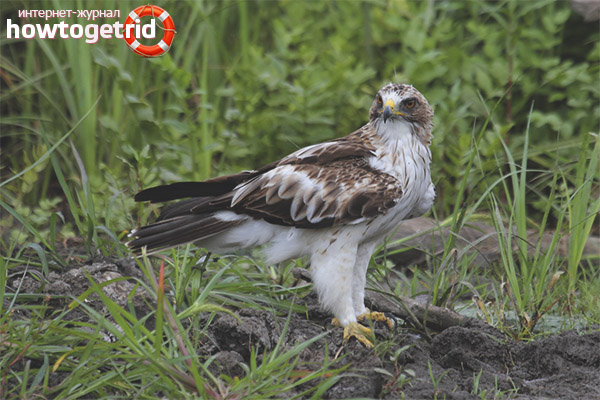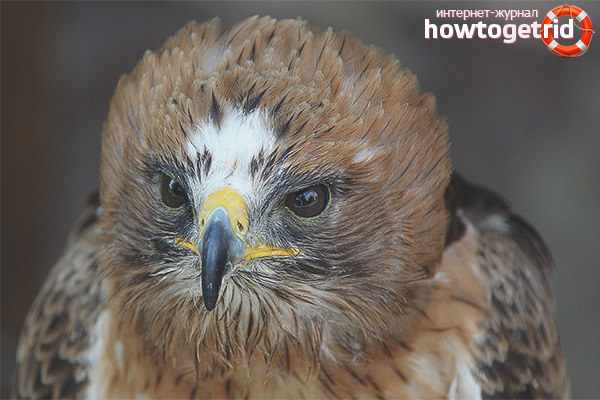The content of the article
A dwarf eagle is a small bird similar in size to a buzzard, it is distinguished by its mobility and excellent flight characteristics. This bird is known for the large size of its wings, which are strongly narrowed, and a long tail. These eagles have a different manner of flight, they are able not only to soar at high altitude, following the example of their closest relatives, but also to perform shaving flights, slightly bending their wings. Despite their small size, these birds do not show the inherent caution of other eagles.
The length of the body of the predator is 53 centimeters, the width of the wingspan reaches 132 centimeters, the maximum weight of an adult reaches 1300 grams. Females of these birds are superior in size to males, but they are colored the same. Their tail unit in the lower part has a light shade, there are no transverse stripes on the tail.
The beak model is similar in appearance to the beak of other species of eagles; it has an end bent to the bottom. The beak of the bird is small in size, it is painted black. Feet of yellow color, "equipped" with black claws, on its legs there is plumage reaching to the fingers of the bird.
The plumage on the legs of the bird served as the reason for its second name, which has been preserved in various scientific works of French as well as English authors; it literally sounds like “feathered”.
During its life, the dwarf eagle has to change the nature of its plumage several times. A chick is born, dressed in a downy outfit of yellow-white color with blue eyes. Having reached the age of two weeks, it molts and becomes covered with a fluff of a pale gray shade. And, only after three months, the birds receive their constant plumage.
The color of the dwarf eagle is different, it is divided into two types, which are called "morphs". The first type includes individuals whose coloring mainly consists of dark plumage, and the second includes birds with light plumage, and light individuals are more widespread.
Representatives of the dark type of plumage have a brownish-brown color, both above and below, and they often have a reddish or golden tone in the plumage of their head. Similar plumage colors are characterized by most of all eagles. Dwarf eagles have the greatest similarity with buzzards, as well as with black kites. But the presence of a large head, on which a massive beak is located, as well as strong legs covered with thick plumage at this bird, makes it possible to recognize a dwarf eagle in a flying predator.
Eagles of this species are quite noisy birds, especially when it comes to the mating season. They often use an intense whistle, which is very reminiscent of the sounds made by a tie, and at times their whistle resembles the calls of buzzards. During periods of mating, they use a scream that characterizes most eagles, but they use a higher tonality. And sometimes they make vibrating sounds resembling a rattle.
Habitat
The dwarf eagle selects for its nesting narrow zones located along the entire Atlantic coast of northwestern Africa. On the coast of the Mediterranean Sea it can be found, ranging from Morocco to Tunisia itself. In areas located south of the High Atlas, as well as in the central part of Tunisia, the bird is no longer found.
Within Europe, the largest population of these birds is located on the territory of the Iberian Peninsula, and they are also found in the central part of France north of the Ardennes. Single nests of dwarf eagles can be found in Greece and northern Turkey, as well as throughout eastern Europe.
On the territory of the Russian Federation, the bird lives only within two limited areas. The first of them is the western one, located on the European section of the country, it is noted east of Tula, as well as the Tambov region. The second is eastern, it is located from Altai to Transbaikalia.
Nesting sites of the dwarf eagle, located south of the borders of Russia, are located in the Caucasus, central Asia, northern India and eastern Mongolia. A separate small population of this species of eagles can be found in the Cape.
Dwarf Eagle
The eagle’s legs possessing great strength, “equipped” with tenacious claws located on the long fingers of the bird, as well as its strong beak and sufficiently large wings, allow the predator to hunt for game moving at high speed. For its size, it’s even strange that it is able to cope with large opponents, one of which may be a rabbit. This eagle does not experience any addiction to a certain type of prey; the group of animals on which it declares a hunt determines the nature of the area in which it lives.
The dwarf eagle is capable of catching birds, both on the ground and in the air, that are small or medium in size, and if necessary, does not disdain eggs found in their nests. In areas with arid characteristics, hunting is carried out for reptiles, it is able to neutralize the poisonous reptile with one accurate and powerful blow.
The process of breeding offspring
Dwarf eagles have one individual trait - they always strive to return to the place where their nest is located. It is noteworthy that both partners fly apart to the place of wintering, and do not see each other throughout the winter period. However, with the onset of spring, they return to their nest and meet after winter separation.
When the meeting took place, the male first thing in a hurry to surprise his female with the skill of his flight and the ability to reach recklessness in risky maneuvers. Using a model of a narrow imaginary spiral for lifting, he rises into the sky to a height of about 800 meters, freezes for some time in the sky, withstanding a theatrical pause and folding his wings, with lightning speed, rushes down, performing an expert feast in front of the earth itself. After that, he again gains height and does this trick again; he often succeeds in executing a dead loop when exiting the peak. The male accompanies the artistry of his tricks with a noisy accompaniment consisting of the screaming of his high voice.
Dwarf eagles arrange their nests from branches of various lengths and thicknesses; they choose a place in the forest, near open areas. Interestingly, to build a nest, they are sure to look for a tree that has a fork at a height of 5 to 18 meters, in which birds build their dwelling. Only in rare cases can a nest be arranged on a thick branch.
In the laying of the female eagle, there are from 1 to 2 eggs, which she lays from the second half of April to the beginning of May. The eggs of these eagles are white, sometimes with a yellowish or greenish bloom, and brown or ocher-colored spots. The incubation period for them is 38 days. After the chicks hatch, the female does not leave the nest for some time, the caring mother warms her offspring, and the father is engaged in feeding the family.
By the beginning of August, after 60 days, the strong chicks acquire plumage and slowly leave the nest, but at first they do not fly far. The family continues to hold together until the end of August. With the onset of autumn, young individuals are the first to fly on a seasonal flight, and by mid-September, adult birds will fly away.
Video: Dwarf Eagle (Aquila pennata)












Submit